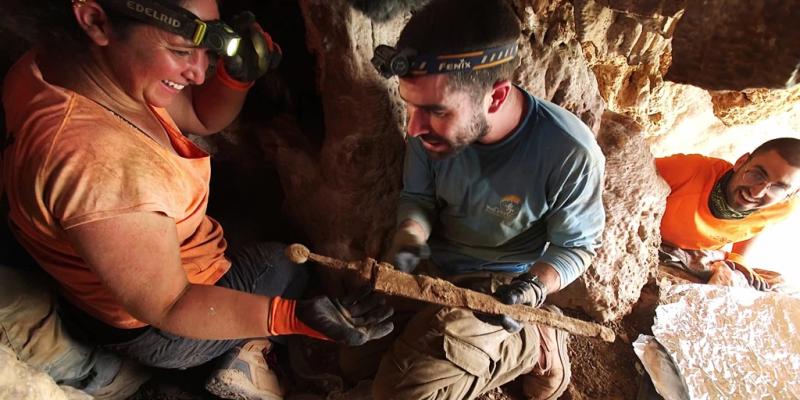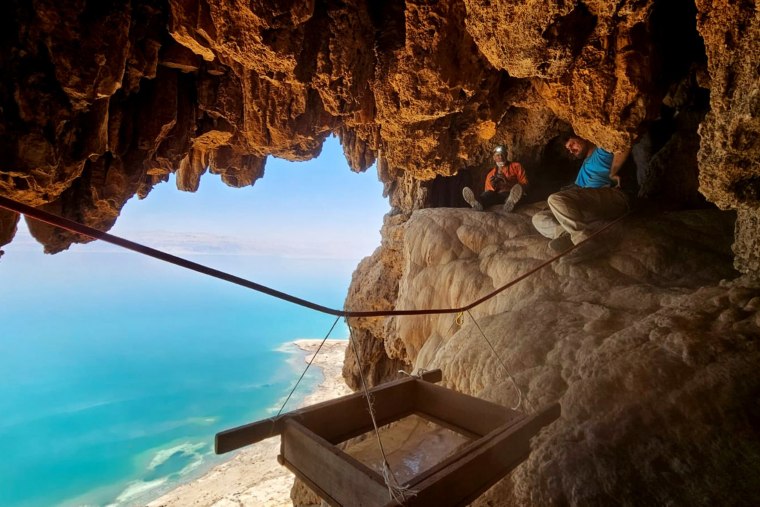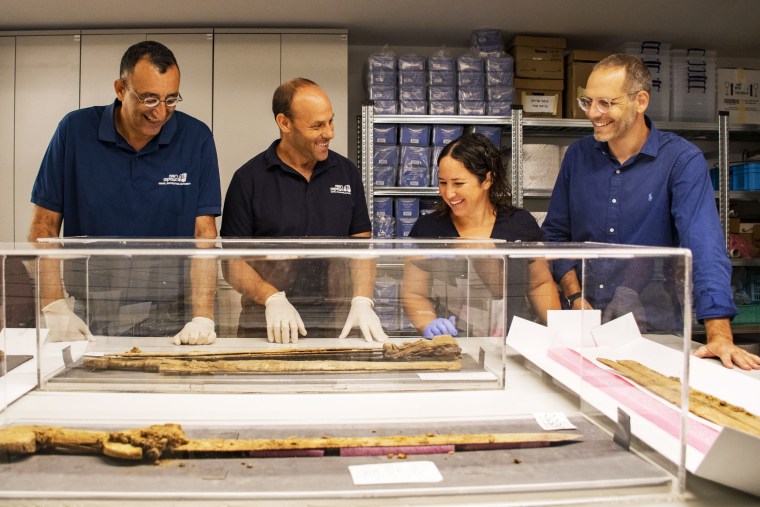Ancient Roman swords discovered in Dead Sea cave



Israeli archaeologists announced Wednesday the discovery of four extremely rare and well-preserved Roman swords in a small hidden cave in an area of isolated cliffs overlooking the Dead Sea.
Experts from the Israel Antiquity Authority were amazed by the nearly 2,000-year-old weapons found, which they said could have been stolen from Roman soldiers by Jewish rebels and then hidden.
Jewish fighters staged a series of revolts against the Roman Empire around this time — further work is ongoing to establish whether the swords can be linked to the Bar Kokhba Revolt in 132-135 A.D. A coin from the time of the revolt was found near the cave entrance, in En Gedi Nature Reserve, about an hour outside Jerusalem.
The team that found the treasure trove had originally gone into the caves to inspect a stalactite with an ancient fragmentary ink inscription in Hebrew from time of the First Temple, also known as Solomon's Temple, which is dated to 990-931 B.C.
A team of three experts recently visited the cave to take multispectral images of the inscription in the hope of revealing additional writing not visible to the naked eye.
 A small team of archaeologists at work in the cave. Hagay Hamer / Israel Antiquities Authority
A small team of archaeologists at work in the cave. Hagay Hamer / Israel Antiquities Authority
One of them, archaeologist Asaf Gayer of Ariel University, noticed a well-preserved pilum, a long-shafted Roman weapon that was typically more than 6 feet long. Nearby were pieces of worked wood that turned out to be the swords' scabbards.
"The hiding of the swords and the pilum in deep cracks in the isolated cave north of 'En Gedi hints that the weapons were taken as booty from Roman soldiers or from the battlefield, and purposely hidden by the Judean rebels for reuse," Eitan Klein, one of the directors of the Judean Desert Survey Project, said in a statement.
"Obviously, the rebels did not want to be caught by the Roman authorities carrying these weapons."
Three of the "exceptionally well-preserved" swords — identified as the Roman spatha variety, used in both war and in gladiator battles — were still in their scabbards and measured 23 to 25 inches in length.
The fourth sword, with a ring at its end or pommel, was shorter and measured just under 18 inches in length. All four were confirmed to be of the type commonly used by Roman soldiers in the period.
Judea, now part of modern-day Israel, had been a Roman ally and then a province from 6 to 132 A.D., when Jerusalem was destroyed after the third Jewish-Roman War.
 Detailed images of the swords recovered from the cave. Dafna Gazit / Israel Antiquities Authority
Detailed images of the swords recovered from the cave. Dafna Gazit / Israel Antiquities Authority
Further excavation of the same cave found artifacts dating as far back as the Chalcolithic period, about 6,000 years ago.
The unique dryness of the desert provides perfect conditions for the survival of ancient artifacts. Last year, experts announced the discovery of silver coins dating back 2,200 years, to the time of the Maccabean Revolt.
"Not all are aware that the dry climatic conditions pertaining in the Judean Desert enable the preservation of artifacts that do not survive in other parts of the country," said Eli Escusido, director of the Israel Antiquities Authority.
"This is a unique time capsule, whereby fragments of scrolls, coins from the Jewish Revolt, leather sandals, and now even swords in their scabbards, sharp as if they had only just been hidden away today."
The Israel Antiquities Authority is carrying out an extensive survey in the caves around the Judean Desert in an attempt to prevent looting. So far, hundreds of caves have been searched and 24 excavations carried out over six years.
 From right: Asaf Gayer, Oriya Amichay, Eitan Klein and Amir Ganor inspect the newly discovered swords. Yoli Schwartz / Israel Antiquities Authority
From right: Asaf Gayer, Oriya Amichay, Eitan Klein and Amir Ganor inspect the newly discovered swords. Yoli Schwartz / Israel Antiquities Authority
"In the course of the project, we unfortunately encountered tens of caves that have been plundered since 1947," said Amir Ganor, director of the Antiquities Looting Prevention Unit at the Israel Antiquities Authority and one of the directors of the survey project.
"I shudder to think how much historical knowledge would have been lost had the looters reached the amazing artifacts in this cave before the archaeologists," he added.





I would have thought that the salt air would have eroded them. I was wrong
Swords were only 23 - 25 inches in length? Damn - that calls for some really, really close fighting, ya think? Serious hand-to-hand.
If I remember right (and I might not be) I think they were trained to get in close and slip the sword between shields.
You are correct. The Gladius for use when the square was formed.
The Spatha and the Gladius were considered to be two of the finest class of swords in the Roman Empire for hundreds of years. The Spatha was longer than the Gladius and considered a heavy weapon while the Gladius was lighter and shorter for use with light infantry legions.
There were some tiny handed SOBs back in those days!
Because it is likely the men were around 5'6" tall. Probably wasn't much different in the US in the 1800s. The Confederate and Union uniforms in the Pea Ridge National Park museum seemed very small in comparison with the average size of a US soldier today.
Dad restored a 1932 Chevy pickup that I couldn't even squeeze behind the wheel with my 6'3".
Average adult male height in the Roman legions was considered to be approximately 5' 6".
So should we travel back in time and kick some serious ass?
Absolutely, let us know when you’re back and how much serious ass you kicked.